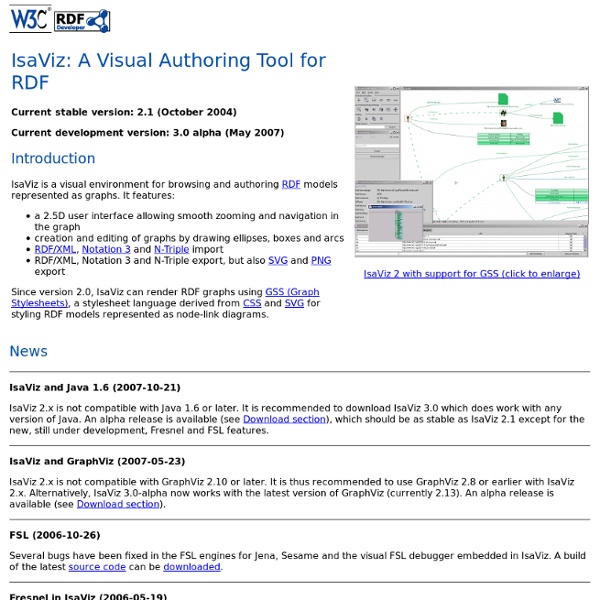What is the Semantic Web really all about?
The Semantic Web is based on the relatively straightforward idea that to be able to integrate (link) data on the Web we must have some mechanism for knowing what relationships hold among the data, and how that relates to some “real world” context. The following is a lot of detail that comes from this simple idea. To answer this question properly, let me start back in the early Web era. While I’m going to do some potentially boring personal history, I’ll note the key ideas as I go along.
aqueduct - Aqueduct Semantic Web Collaboration Framework
Aqueduct, a linked data semantic web extension for Mediawiki (the software that powers Wikipedia), provides widgets that can be placed on wiki pages to structure and visualize semantic data, link to outside semantic datasources, discover data in semantic datasources, and perform queries. Aqueduct is not based on Semantic Mediawiki; rather, it is another Mediawiki extension, separate from the Semantic Mediawiki extension. The main difference between Aqueduct and Semantic Mediawiki is that Aqueduct is optimized for working with semantic (RDF) datasets that are external to the wiki, outside of the wiki's control. The Semantic Mediawiki technology stack is optimized for working with semantic data that's intermingled with the wikitext of the wiki being edited. To install Aqueduct, simply check out a copy of the code and read the HTML documentation contained therein.
Semantic Web FAQ
The term “rules” in the context of the Semantic Web refers to elements of logic programming and rule based systems bound to Semantic Web data. Rules offer a way to express, for example, constraints on the relationships defined by by RDF, or may be used to discover new, implicit relationships. Various rule systems (production rules, Prolog-like systems, etc) are very different from one another, and it is not possible to define one rule language to encompass them all. However, it is possible to define a “core” that is essentially understood by all rule systems.
Getting Things Done with PersonalBrain
Clear Your Mind. Get It Out of Your Head and into Your TheBrain. “First of all, if it’s on your mind, your mind isn’t clear.
Mills College
Mills College is an independent liberal arts and sciences college in the San Francisco Bay Area. Originally founded in 1852 as a young ladies' seminary in Benicia, California, Mills became the first women's college west of the Rockies. Currently, Mills is an undergraduate women's college in Oakland, California, with graduate programs for women and men.
Liouville's theorem (complex analysis
In complex analysis, Liouville's theorem, named after Joseph Liouville, states that every bounded entire function must be constant. That is, every holomorphic function f for which there exists a positive number M such that |f(z)| ≤ M for all z in C is constant. The theorem is considerably improved by Picard's little theorem, which says that every entire function whose image omits at least two complex numbers must be constant. The theorem follows from the fact that holomorphic functions are analytic. If f is an entire function, it can be represented by its Taylor series about 0: where (by Cauchy's integral formula)
Cauchy's integral formula
In mathematics, Cauchy's integral formula, named after Augustin-Louis Cauchy, is a central statement in complex analysis. It expresses the fact that a holomorphic function defined on a disk is completely determined by its values on the boundary of the disk, and it provides integral formulas for all derivatives of a holomorphic function. Cauchy's formula shows that, in complex analysis, "differentiation is equivalent to integration": complex differentiation, like integration, behaves well under uniform limits – a result denied in real analysis. Theorem[edit] where the contour integral is taken counter-clockwise.
Differentiable function
A differentiable function Differentiable functions can be locally approximated by linear functions. More generally, if x0 is a point in the domain of a function f, then f is said to be differentiable at x0 if the derivative f′(x0) exists. This means that the graph of f has a non-vertical tangent line at the point (x0, f(x0)). The function f may also be called locally linear at x0, as it can be well approximated by a linear function near this point.
Complex analysis
Murray R. Spiegel described complex analysis as "one of the most beautiful as well as useful branches of Mathematics". Complex analysis is particularly concerned with the analytic functions of complex variables (or, more generally, meromorphic functions). Because the separate real and imaginary parts of any analytic function must satisfy Laplace's equation, complex analysis is widely applicable to two-dimensional problems in physics.
Cauchy's integral theorem
In mathematics, the Cauchy integral theorem (also known as the Cauchy–Goursat theorem) in complex analysis, named after Augustin-Louis Cauchy, is an important statement about line integrals for holomorphic functions in the complex plane. Essentially, it says that if two different paths connect the same two points, and a function is holomorphic everywhere "in between" the two paths, then the two path integrals of the function will be the same. Statement of theorem[edit] The theorem is usually formulated for closed paths as follows: let U be an open subset of C which is simply connected, let f : U → C be a holomorphic function, and let be a rectifiable path in U whose start point is equal to its end point. Then



